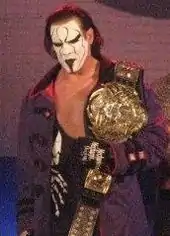Gimmick (professional wrestling)
In professional wrestling, a gimmick generally refers to a wrestler's in-ring persona, character, behaviour, attire and/or other distinguishing traits while performing which are usually artificially created in order to draw fan interest.
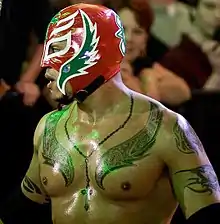
These in-ring personalities often involve costumes, makeup and catchphrases that they shout at their opponents or the fans.
Gimmicks can be designed to work as good guys/heroes (babyfaces) or bad guys/villains (heels) depending on the wrestler's desire to be popular or hated by the crowd. A tweener gimmick falls between the two extremes. A wrestler may portray more than one gimmick over their career depending on the angle or the wrestling promotion that they are working for at that time.
Promotions will use gimmicks on more than one person, albeit at different times, occasionally taking advantage of a masked character which allows for the identity of the wrestler in question to be concealed. Razor Ramon was portrayed by both Scott Hall and Rick Bognar.
Occasionally, a wrestler uses a gimmick as a tribute to another worker; such is the case of Ric Flair's Nature Boy persona which he took on as an homage to the original Nature Boy, Buddy Rogers.
When a wrestler acts outside his or her gimmick this is known as 'breaking kayfabe', a term showing pro wrestling's linkages to theatre, where the more common term "breaking the fourth wall" is used.
Gimmicks are annually rated for the Wrestling Observer Newsletter awards by the publication's owner, professional wrestling journalists, and various industry insiders, such as Dave Meltzer, promoters, agents and performers, other journalists, historians, and fans. The two awards are given to the best and worst gimmick of that year. Current winners are "The Fiend" Bray Wyatt and Shorty G respectively.
History

Beginnings (1860s to 1940s)
Pro wrestling's history has been tied to the use of gimmicks from its infancy. From its circus origins in the 1830s, showmen presented wrestlers under names such as “Edward, the steel eater”, “Gustave d’Avignon, the bone wrecker”, or “Bonnet, the ox of the low Alps” and challenged the public to knock them down for 500 francs.[1]
During the late 19th century-early 20th century, when wrestler Frank Gotch rose to prominence, the focus became on contests largely legitimate (see catch wrestling), which largely resulted in the abandoning previous character gimmicks.
Television era (1950s to 1970s)
It was not until the First Golden Age of Professional Wrestling in the United States during the 1940s–1950s, when Gorgeous George created pro wrestling's first major gimmick. His heel character focused on his looks and quickly antagonized the fans with his exaggerated effeminate behavior, drawing jealousy to the fans. Such showmanship was unheard of for the time; and consequently, arena crowds grew in size as fans turned out to ridicule George.[2]
Gorgeous George's impact and legacy on wrestling gimmicks was enormous, demonstrating how fast television changed the product from athletics to performance. Before him, wrestlers gimmicks imitated "ethnic terrors" (Nazis, Arabs, etc.), but his success birthed a more individualistic and narcissist form of character.[3]
He was one of the first pro-wrestlers to use entrance music, "Pomp and Circumstance" which always played as he made his way to the ring.[4]
In Britain, television took British wrestling to the next level when in 1964, it went full-time as part of the World of Sport show.
The style of wrestling at the time was unique with strong emphasis on clean technical wrestling. Heels made up a minority of the roster, with most shows containing an abnormally high proportion of clean sportsmanly matches between two "blue-eyes" (as faces were known backstage in the UK). This would remain the case for several decades to come. Gimmick matches were a rarity, midget wrestling failed to catch on, while women were banned by the Greater London Council until the late 1970s.
Explosion (1980–present)
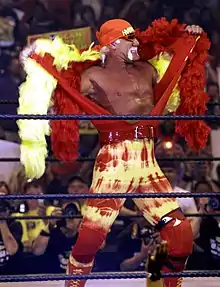
During the Second Golden Age of pro wrestling in the 1980s–1990s a rise of cartoonish, outlandish gimmicks became popular with the increase of the World Wrestling Federation's popularity.
The WWF contributed to the explosion of gimmicks by becoming the most colorful and well-known wrestling brand because of its child-oriented characters, soap opera dramatics and cartoon-like personas. Most notable was the muscular Hulk Hogan, who marked the 1980s with his "all-American" gimmick and made his main events into excellent ratings draws. His dominant role in the industry at that time led to this era to be also known as "Hulkamania". Around this time, wrestling became a form of entertainment rather than an official sport.
Other wrestlers from this era with similarly outlandish characterization include Ric Flair, Sting and The Undertaker.
In recent years, the emphasis has been on more realistic gimmicks that portray the wrestler as an actual person, sometimes using their real names, albeit with exaggerated personality traits. Wrestlers like Randy Orton, Batista, and John Cena are prime examples of this.[5]
Common gimmicks
Related to origin
Exaggerating the characteristics of a wrestler's (on occasion fabricated) origin is one of the most commonly exploited gimmicks, in which overarching characteristics of a character play up to clichés and stereotypes.
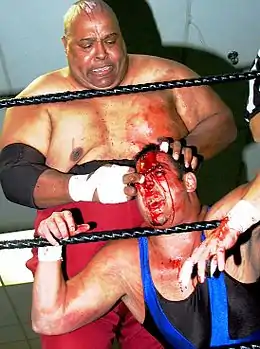
A long list of wrestlers in this category includes: Albanian (Rezar), Arab (The Sheik, Muhammad Hassan), African (Kamala, Abdullah The Butcher), American (The Patriot, Hulk Hogan, 'Hacksaw' Jim Duggan, Jack Swagger), Australian (The Bushwackers, Outback Jack, Nathan Jones, Buddy Murphy), Austrian (Walter), Brazilian (Arturo Ruas, Taynara Conti), Bulgarian (Rusev), Canadian (Team Canada (TNA), Team Canada (WCW)), Chinese (Xia Li), Cowboy (Bob Orton Jr.), Cuban (Razor Ramon), Dominican (No Way Jose), Dutch (Aleister Black), English (William Regal, Lord Alfred Hayes, Gentleman Jack Gallagher), Fijian (Jimmy Snuka), French (La Résistance), German (Alexander Wolfe, Marcel Barthel), Guyanese (Ezekiel Jackson), Hawaiian (Leilani Kai, Ricky Steamboat), Indian (The Great Khali, Jinder Mahal), Iranian (The Iron Sheik, Ariya Daivari), Irish (Finlay, Sheamus), Israeli (Noam Dar), Italian (FBI, Santino Marella, Fabian Aichner), Jamaican (Kofi Kingston), Japanese (The Orient Express, Mr. Fuji, Kai En Tai), Korean (Gail Kim), Lithuanian (Aksana), Mexican (Alberto Del Rio, Eddie Guerrero, The Mexicools), Native American/American Indian (Chief Jay Strongbow, Tatanka), New Zealander/Maori (The Sheepherders, Dakota Kai), Puerto Rican (Carlito Colón, Primo and Epico), Polish (Dabba-Kato), Russian (Vladimir Kozlov, Nikolai Volkoff, Lana), Samoan (Samoa Joe, The Wild Samoans, Roman Reigns, The Usos) Scottish (Drew McIntyre, Roddy Piper), South African (Adam Rose, Justin Gabriel) Swiss (Cesaro), Thai (Super Invader), Tongan (Tama Tonga, Tanga Loa), and Welsh (Mason Ryan).
The undeniable influence of the Puroresu style in the world of professional wrestling has resulted in many wrestlers using fabricated Japanese origins or being billed from a Japanese city, without actually being natives of the country. Prime examples of this include Yokozuna, Awesome Kong, Hawaiians Professor Tanaka and Mr. Fuji, and British wrestler Kendo Nagasaki. Several Japanese wrestlers who wrestle outside of their home country are known to play up or exaggerate aspects of their cultural heritage as part of their gimmicks for an overseas audience.
Masked
.jpg.webp)
Masked wrestlers made their appearance in Europe (Theobaud Bauer in France, 1865) and the United States (Mort Henderson as "Masked Marvel" in 1915) considerably earlier than in Mexico, but it was the latter that popularised the use of masks. This, in some cases to signify a high-flyer style, influenced by Lucha Libre.
A specific masked gimmick may be used by more than one wrestler at a wrestling company's request since their identity can be permanently concealed. This is the case of Mexican Sin Cara and Japanese Tiger Mask. Masks also allow a wrestler to perform as more than one character for a variety of wrestling promotions.
Other wrestlers that have used masks in their performances include: Mexican-Americans Rey Misterio, Big Van Vader, or Japanese legend Jyushin Thunder Liger.
Sports
A high number of wrestlers who start their careers in another sport incorporate their athletic abilities as part of their act. That is the case for Olympic medallist Kurt Angle, who previously competed in freestyle wrestling and alludes to it in his attire and wrestling style. Brock Lesnar is also an ex-amateur wrestler, NFL player and UFC champion. Former MMA fighters Ronda Rousey and Shayna Baszler also uses their MMA background as part of their characters as well as former American Ninja Warrior competitor Kacy Catanzaro, former kung-fu fighter Xia Li, and Matt Riddle, who always wrestles barefooted during matches, presuming that he had an MMA background career in the past before debuting in WWE.
Superheroes, supervillains and other comic characters
The theatrical nature of professional wrestling easily blends with comic hero and villain characters, made popular in the 1980s by legend The Ultimate Warrior and Sting, whose character was inspired by the 1994 movie The Crow, based on the comic book of the same name.
Other wrestlers with superhero and supervillain gimmicks include late WWE Hall of Famer Dusty Rhodes' sons Gold and Stardust, Samoan Rosey during his "the Super Hero in Training" (the S.H.I.T.) phase and his tag-team partner The Hurricane and valet Super Stacy.
Some of these characters are brought during very short periods of time for entertainment value. The Joker and Harley Quinn from the Batman comics have inspired wrestling attire for Sting and Alexa Bliss respectively. Finn Bálor's Demon King persona is visually based on Spider-Man villains Venom and Carnage. Sandman's gimmick name is also based on Spider-Man villain Sandman.
Supernatural
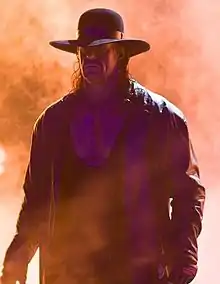
Similarly to superheroes and supervillains, supernatural characters add to entertainment value. Most famously in this category is The Undertaker, considered one of the most respected wrestlers in the business, whose gimmick is a horror-themed character of an undead, macabre and paranormal dark presence prone to scare tactics. He was managed by the ghostly character that was Paul Bearer and tagged with his half-brother Kane in The Brothers of Destruction stable.
Other wrestlers displaying supposed supernatural powers include Matt Hardy (as his Broken/Woken persona), and his younger brother Jeff Hardy (as his Brother Nero/Willow character), Mordecai, Jake "The Snake" Roberts, Papa Shango, The Boogeyman, and most recently Aleister Black and Bray Wyatt's The Fiend. Japanese Onryo portrays a dead wrestler who returned for vengeance.
The Brood was a vampire stable, composed of Gangrel, Christian and Edge.[6]
Juggernaut
Since its beginnings in the circus circuit, the professional wrestler's stereotype has been that of large, powerful and strong. Various wrestlers have banked on the larger size which has influenced their in-ring style and persona.
Notable examples of these kind include Swede Tor Johnson (181 kg), Gorilla Monsoon (182 kg), Giant González (8 ft 0 in), André the Giant (7 ft 4 in), The Great Khali (7 ft 3 in), Big Show (7 ft 2 in), Awesome Kong and Nia Jax (123 kg).
Midget
Similarly to juggernauts, since its beginnings in the circus circuit, the professional wrestler's stereotype has been that of small, but powerful and strong like those of dwarves of Norse mythology. Various wrestlers have banked on the small size which has influenced their in-ring style and persona.
Notable examples of these kind include the leprechaun Hornswoggle, El Torito and other various dwarfed versions of other various wrestlers.
Comedy
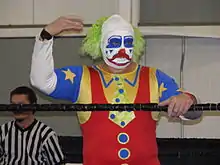
Whilst humor has long been present in professional wrestling matches and many wrestlers incorporate elements of comedy in their act, full-on comedic gimmicks are not commonly seen. These are sometimes reserved for wrestlers who not always have the stereotypical physique required in the industry and instead exploit their entertainment abilities.
Wrestlers who fall under this category are Scottish comedian and actor Grado, Doink The Clown which was majorly portrayed by Matt Osborne until 2013, Ring of Honor's Colt Cabana, Santino Marella, James Ellsworth, Japanese Wrestlers Stalker Ichikawa, Gran Naniwa, Kuishinbo Kamen and Toru Yano, Charlie Haas during his impersonations run, and WWE's 1990s turkey character Gobbledy Gooker and Al Snow along with his mannequin prop called "Head" which he used as a sidekick companion during segments while addressing the fans. Damien Sandow also falls under this category due to his 'stunt double' gimmick in late 2014 where he copied whatever his on-screen mentor The Miz did, due to the latter using a gimmick of an arrogant movie star.
Educational
Whilst "education" is rare in wrestling, it has been recently been a popular gimmick due to the fact that the wrestler is a former student of a school, college, university, or TAFE, or a even a coach, dean, teacher, or even a principal. Wrestlers who used this gimmick include NXT wrestlers, e.g. Alex Riley etc., Sgt. Slaughter, Dean Douglas, Eugene's "mentally disabled boy" character, Michelle McCool's "sexy teacher" character, The Miz's and Jack Swagger's "student" amateur background characters, and David Otunga's strict lawyer character, and tag team The Spirit Squad.
Religious
Religion is often a rare gimmick since that fans are not quite interested in it either. Wrestlers who used this are "Bolieve" Bo Dallas, and most recently, "The Monday Night Messiah" Seth Rollins,
Charity
Charity characters are depicted as a heroic gimmick due to real-life charity. Wrestlers who used this gimmick include "Make a Difference" Fatu, and "The Doctor of Hug-o-nomics" Bayley, and tag team The Street Profits.
Music
Music influences are another popular choice for gimmicks, as demonstrated by John Cena's original rapper character along with R-Truth, CM Punk's straight edge iconoclast hardcore punk, party boys No Way Jose and Adam Rose, Elias, Chris Jericho, Jeff Jarrett, The Honky Tonk Man, Disco Inferno, WWE's Brodus Clay and his fun-loving, funk dancing gimmick "The Funkasaurus" and Fandango who includes salsa dancing in his routine, and AEW's Jack Evans who usually does breakdancing in the ring during entrances or when he's won a match, and tag teams The Public Enemy, Badd Company, The Rockers, The Rock 'n' Roll Express, and The Rhythm and Blues.
Hardcore technician
Hardcore technicians are also another popular choice for gimmicks, these include ECW wrestlers, e.g. New Jack, Hardcore Holly, etc., and tag teams The Road Warriors, Demolition, KroniK, The Ascension, The Mechanics, The Machines, Heavy Machinery, and War Machine.
Self-absorbed
Usually a villainous gimmick, initiated by Gorgeous George, due to the jealousy of the good looks the fans want to have for themselves. Wrestlers that followed on with this trend include "The Dream" Velveteen Dream, "The Untouchable" Carmella, "The Best In The World" Lana, "Dashing" Cody Rhodes, "The Black Machismo" Jay Lethal, "The Artist Collective" Sami Zayn, "The Masterpiece" Chris Masters, Heath Slater, Byron Saxton, Dolph Ziggler, The Miz, Randy Orton, Carlito Caribbean Cool, "The Phenominal" AJ Styles, "Glorious" Bobby Roode, "The Almighty" Bobby Lashley, "The Golden Standard" Shelton Benjamin, "The World's Strongest Man" Mark Henry, "The Heartbreak Kid" Shawn Michaels, "Big Sexy" Kevin Nash, Ravishing Rick Rude, Razor Ramon, "The Model" Rick Martel, "Macho Man" Randy Savage, "Handsome" Harley Race, TNA's Mr Pec-tacular, Billy Gunn's Mr. Ass, Curt Hennig's Mr Perfect, NXT's Tyler Breeze, and Lacey Evans, and tag teams The Vaudevillains, The Mexicools, and MNM, as well as women's tag teams The Beautiful People, LayCool, and The IIconics.
Hollywood movie star
Hollywood movie stars are occasionally villainous due to fame outside of wrestling as a real-life actor/actress. These include Hulk Hogan, The Rock, Batista, and David Otunga's A-list character.
Authority figure
.jpg.webp)
Authority figures are apparently villainous as wrestlers but sometimes as heroic characters as non-wrestlers (e.g. referees) as well depending on the storyline. These include non-wrestlers like managers, and wrestlers like Big Boss Man, "The Alpha Male" Marcus Cor Von, Consequences Creed, "The Man" Becky Lynch, "The Boss" Sasha Banks, and tag teams New World Order, Right to Censor, The Truth Commission, The Acolytes Protection Agency, The Authors of Pain, The Shield, and The Authority.
Evil billionaire/Millionaire tyrant
The evil billionaire/millionaire tyrant character works well as a villain; due to the jealousy of the money the fans want for themselves; in contrast to professional wrestling's working-class fan-base. It is because of this audience that Dusty Rhodes' Common Man or "American Dream" was highly successful with the crowds.
The original gimmick of this type was created by "Million Dollar Man" Ted DiBiase which consequently inspired wrestlers like his son, Mr. McMahon and his son, Hunter Hearst Helmsley, JBL, Tiger Ali Singh, and most recently, Alberto Del Rio's arrogant rich Mexican aristocrat character, and tag teams The Diamond Exchange, The Beverly Brothers, The Blue Bloods, and most recently, The Hurt Business.
Ruthless ruler
Similarly to evil billionaire/millionaire tyrant characters, ruthless ruler characters are mostly a villainous gimmick based on real-life royals, nobles, aristocrats, monarchs, imperials and empires. Wrestlers who used this gimmick include Jerry "The King" Lawler, King Corbin, King Booker, William Regal's arrogant noble English ambassador character and his manager Sir William, "The Nature Boy" Ric Flair and his daughter, and tag teams The Kingdom, The Nation of Domination, The Kings of Wrestling, and most recently, The Undisputed Era and The Imperium.
Hated crime gang/Terrorist thugs/Bad guy bandits/Mafia mobsters
Hated crime gang/terrorist thugs/bad guy bandits/mafia mobsters work perfectly well as a villainous tag teams due to real-life crime gangs, terrorist thugs, bandits, and mobsters. These include tag teams Riott Squad, The Forgotten Sons, Social Outcasts, Cryme Tyme, D-Generation X, The New Age Outlaws, The Disciples of Apocalypse, Aces & Eights, The Bullet Club, The Gangstas/The Gangstanators, Enzo Amore and Big Cass, La Familia, LAX, Mexican America, FBI, and most recently, Retribution.
Other usage
- Within professional wrestling in insider usage the word 'gimmick' has come to refer to an array of other related terms, including any weapon or foreign object used during a match or the scripted quality of a match.[7]
- In backstage lingo, gimmick is also a stand-in for basically any physical noun or set of moves in a match.
- Gimmicked is used to describe an object that is altered or rigged for use in a match. For example, a gimmicked table or chair which would be precut or made to fall apart more easily.[8]
- The term is also a euphemism for hormone-enhancing drugs, namely steroids and growth hormone, which have historically been linked to the sport.
- It has also been used by people in the profession to describe casual marijuana use, as wrestlers will refer to 'smoking the gimmick'.
Notes
- "History of Wrestling - United World Wrestling". unitedworldwrestling.org. Archived from the original on 2016-03-27. Retrieved 2016-02-08.
- Thesz, Lou. Hooker. p. 100.
- Assael, Shaun. Sex, Lies, and Headlocks. p. 11.
- Foley, Mick (2010). The Fabulous, Freaky, Unusual History of Pro Wrestling (Unusual Histories). Velocity Business Publishing. pp. 48. ISBN 1429647892.
- ""CHARACTER" ACTORS - Jim Cornette.com". jimcornette.com.
- Shields, Brian; Sullivan, Kevin (2009). WWE Encyclopedia. DK. p. 46. ISBN 978-0-7566-4190-0.
- Shoemaker, David (13 August 2014). "Grantland Dictionary: Pro Wrestling Edition".
- "Wrestling Dictionary of Terms".
